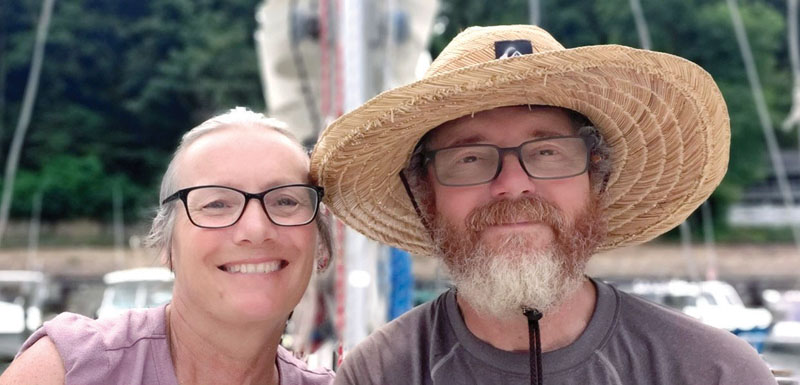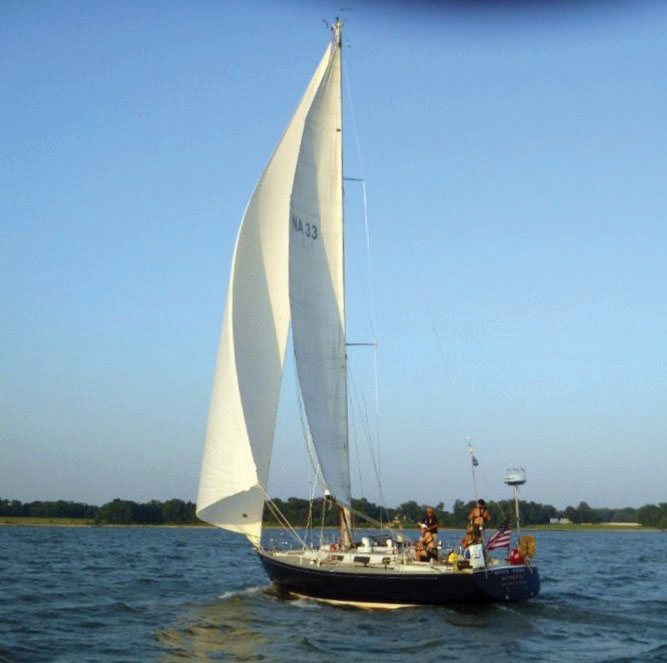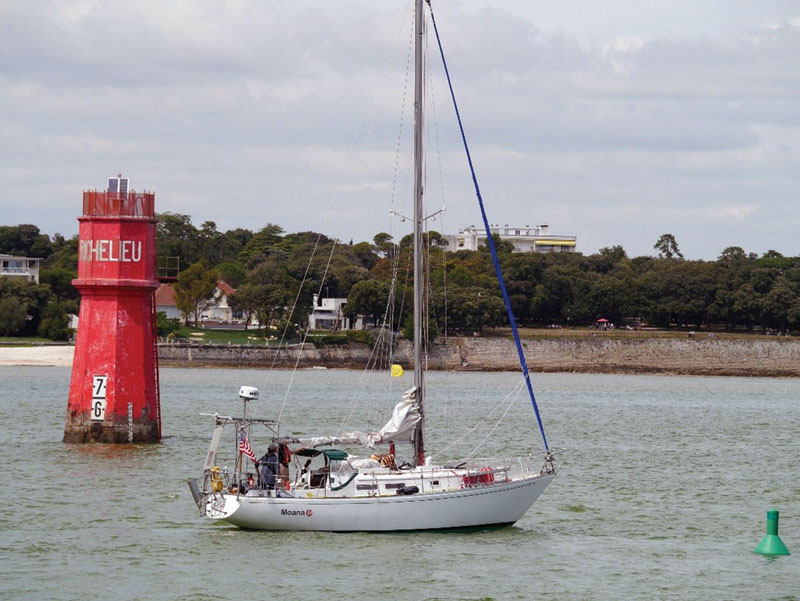Sailing was a match.
Sylvie Duverger began sailing as a 12-year-old when her father gave her an Optimist sailboat “in order to keep his teenage daughter out of trouble.” At the time, her father was in the French military, and the family lived in Bora Bora. The Optimist was the only sailboat on the island. With no one to teach her, Sylvie learned to sail the small boat by herself and continued to sail until her 20s.

It wasn’t until she settled in Maryland that Sylvie began sailing again, nearly 30 years later. “The kids had moved out, and my husband, Philippe, and I began looking for activities we could do together.” Sailing was a match for both.
From student to boat owner and instructor
In 2011, Sylvie joined the Pentagon Sailing Club (PSC) and took the ASA basic coastal and weather courses. She became more involved at the club by sharing her sailing skills with other members. She eventually got her ASA teaching certifications along with an OUPV (Operator of Uninspected Passenger Vessel) license, also known as the “Six-Pack” or Charter Boat Captain’s License. Sylvie then became one of the teaching skippers at PSC introducing students to sailing on the Potomac River. She particularly enjoys sharing her sailing moments with both novice and seasoned women sailors.
In 2013 the couple bought a 34-foot Seafarer built in 1974, a sailboat classic! From the beginning, Sylvie wanted to fulfill her father’s dream of sailing across the Atlantic. They rebaptized the boat Moana, a Polynesian name meaning “ocean,” and spent the next six years rebuilding the boat: “new rigging, new engine, new electrical system, new sails, everything to make the boat ready for the ocean.”
Sylvie and Philippe spent most of those years sailing the Chesapeake with some ocean trials along the East Coast and Bermuda. “The boat always handled well, and we both improved our sailing skills.”

In 2014, Sylvie, like many other PSC members, started volunteering at the Annapolis Naval Academy coaching midshipmen who were participating in the CSTS (Command and Seamanship Training Squadron) summer program. The program enables midshipmen with no sailing experience to become relatively competent sailors within one week, after which they sail a 44-foot boat along the East Coast working on their leadership and teamwork skills. The crews are coed and consist of eight midshipmen and two volunteers. “It is a challenging and rewarding experience to witness a crew of Navy students overcome the challenges of ocean sailing and return to the Santee Basin with a new sense of seamanship.”

Crossing the Atlantic
In June 2021, Phillipe and Sylvie began their first cross Atlantic voyage. Although the winds were quite variable, it wasn’t until they were just north of the Azores that they hit a major gale. “For three days we encountered disorganized seas, high winds, and cold weather. We alternated watches every three hours. We were exhausted, cold, wet, and feeling stuck for a long time—that was the worst part.”
At one point during the night when Sylvie was at the helm, a huge wave broached the boat. Sylvie remembers telling herself not to let go of the wheel. She landed in the water on the deck with her feet up in the air. Within three seconds the boat had righted, leaving Sylvie in shock. Philippe rushed up on deck and managed to heave-to for the remainder of the storm. Fortunately, there was only minor damage to the boat.
On July 11, after 40 days at sea, they finally reached La Rochelle, France, on the Bay of Biscay, where Sylvie had once lived. They stayed in La Rochelle over the summer, worked on repairs, and moved the boat first to Coruna, Spain, then to Lagos, Portugal.
The return trip the following year was relatively uneventful with steady trade winds pushing Moana the entire way. Their return journey took 47 days, and the sight of the number 14 red buoy marking the entrance to Chesapeake Bay was cause for celebration!
Sylvie shared her transatlantic story with PSC members showing a short video and describing how much she enjoyed the challenge of shorthanded sailing across the Atlantic on a small sailboat. “Sure, our boat is relatively slow and storage is limited, but that means more time on the water and fewer marina fees!” Sylvie remarked as well, “Sailing skills alone do not achieve your cruising goals; you need crew members who work well together, and you also need a well-prepared boat.”
Women on Water
Sylvie continues to teach the ASA 101 and 102 courses at PSC. As a skipper for PSC’s Women on Water group, Sylvie is of the opinion that women-only crews have a different dynamic than mixed or men only crews. “There is a camaraderie and a laid-back approach that better enables women-only crews to practice and improve their sailing capabilities. Of course, at PSC the post-sail social gatherings with anecdotes and refreshments are a valuable complement to the on-the-water sessions.”
Moana fits the bill.
Meanwhile, Sylvie and Philippe continue their journey with Moana. Last June, the couple sailed Moana to Penobscot Bay, ME, and the couple plans to sail around the Caribbean islands when Philippe retires in a few years. In the meantime, they continue to explore the Chesapeake.
Despite her accomplishments as a sailor, Sylvie remains adamant that “sailing expertise is only part of it; you need a good boat.” Moana fits the bill!
by Julie Day, with Sylvie Duverger




